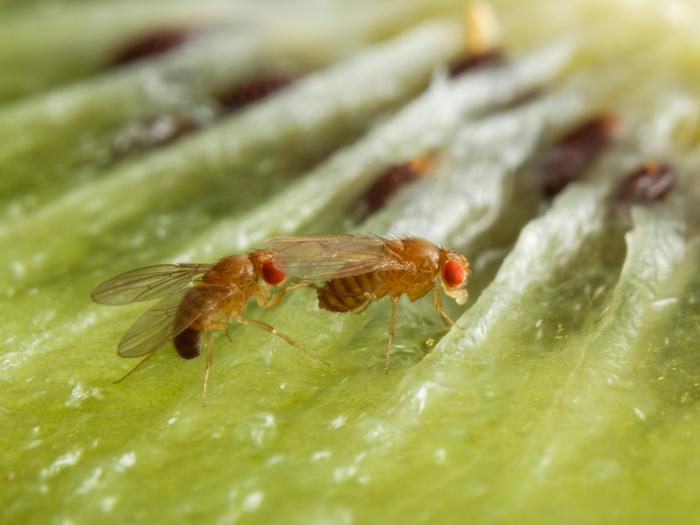In a groundbreaking study led by researchers at the Max Planck Institute for Chemical Ecology, it has been unveiled that the consumption of alcohol enhances the sexual attractiveness of male fruit flies, specifically Drosophila melanogaster, through increased production of sex pheromones. This remarkable finding suggests that alcohol, at specific concentrations, not only alters the behavior of these tiny insects but also boosts their mating success, offering insights into chemical ecology and neurobehavioral responses to environmental factors.
Drosophila melanogaster, commonly known as the vinegar or pomace fly, is frequently found in rotting fruit, where the yeasts and microorganisms contribute to the production of alcohol via fermentation. While humans typically regard excessive alcohol consumption as detrimental to their health and social interactions, male fruit flies appear to benefit from moderate alcohol intake, becoming notably more appealing to females after consuming it. This phenomenon raises intriguing questions about the interactions of dietary substances, mating behaviors, and evolutionary strategies among insects.
The researchers delved into the underlying mechanisms that facilitate this transformation, primarily focusing on how alcohol influences the production of pheromones in male flies. It was discovered that the alcohol molecule, particularly methanol, not only stimulates pheromone synthesis but also enhances the male’s ability to attract potential mates. Ian Keesey, the lead author of the study, emphasizes that the increase in pheromone levels directly correlates with improved mating success, suggesting a complex interplay between physiological states and behavioral outcomes.
Equally fascinating is the manner in which Drosophila melanogaster detect and respond to alcohol concentrations in their environment. Male flies show a distinct attraction to alcohol-laden areas, yet they must navigate the potential dangers of overconsumption. It turns out that their brains are equipped with sophisticated neural circuits that assess both the allure and the risks associated with alcohol. This dual assessment allows flies to enjoy the benefits of moderate drinking without succumbing to the adverse effects of intoxication.
The research team identified three interconnected neural circuits responsible for mediating the dualistic nature of alcohol attraction and aversion. This balancing act is quite rare in biological systems, as it demonstrates how different neural pathways work redundantly to process the same stimulus with opposing outcomes. Keesey highlights that such complexity indicates a highly evolved risk assessment mechanism, crucial for survival in the variable environments where these flies thrive.
To further substantiate their findings, the researchers employed a multi-faceted exploratory approach. They utilized imaging techniques to visualize neuronal activity in the fly’s brain, alongside chemical analyses to understand the ecological context of alcohol odors. By observing the fruit flies’ behavior and success rates in mating under various alcohol concentrations, the team provided a robust framework for understanding the broader ecological implications of alcohol consumption.
The inherent attraction to alcohol among these flies is not merely a whimsical trait but also serves an evolutionary purpose. Drosophila melanogaster has adapted to thrive in environments rich in fermented fruits, where the presence of alcohol represents a nutritional resource. By consuming moderate amounts of alcohol, the males not only heighten their sexual appeal but also reinforce reproductive strategies that maximize their genetic contribution to subsequent generations.
Interestingly, the implication of this research extends beyond the laboratory. It highlights the importance of considering natural behaviors and ecological interactions when studying behavioral and physiological processes in animal models. As Bill Hansson, the head of the Department of Evolutionary Neuroethology, notes, understanding the contextual relevance of such findings could illuminate the complexities of alcohol’s impact across different species, including humans.
It is crucial to remember that this study draws a stark contrast between the experiences of male fruit flies and human males concerning alcohol consumption. While the former are portrayed as triumphant in their mating successes post-drinking, the latter often find themselves entangled in societal pitfalls and complications accrued from excessive drinking. This divergence raises important discussions about the evolutionary paths taken by different species in relation to dietary behaviors and mating outcomes.
As researchers continue to unpack the remarkable world of Drosophila melanogaster, this investigation offers a glimpse into the intricate connections between chemistry, neural processing, and behavior. By elucidating the neuroecology of alcohol attraction and its effects on courtship rituals, the study serves as a valuable contribution to our understanding of animal behavior in naturalistic settings and reflects the vast potential for future research in this fascinating area.
There is much to learn from the wine-sipping flies. Their unique adaptations not only speak to evolutionary strategies but also prompt investigations into the biochemical pathways linked to pheromone production and sensory processing. As we unveil the layers of complexity in these miniature organisms, we also glean insights applicable to broader questions in animal behavior, evolutionary biology, and even human psychology.
Overall, this new understanding of how alcohol influences mating behaviors in fruit flies may lead to further studies examining the role of environmental factors on reproductive success across a diverse range of species. As scientists delve deeper into this intriguing interplay, the fine balance that governs attraction and aversion could one day tell us more about our own relationships with substances in our environments.
Subject of Research: Animals
Article Title: Neuroecology of alcohol risk and reward: methanol boosts pheromones and courtship success in Drosophila melanogaster
News Publication Date: 2-Apr-2025
Web References: Science Advances
References: DOI 10.1126/sciadv.adi9683
Image Credits: Anna Schroll
Keywords: Drosophila melanogaster, alcohol consumption, pheromone production, mating success, neurobiology, evolutionary strategy, ecological interactions, sensory processing, chemocommunication, risk assessment, behavioral ecology.




